Thorny Devil Lizard
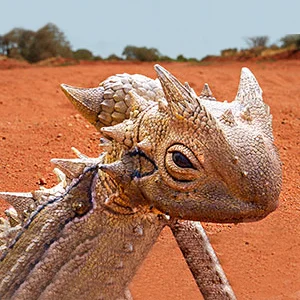
Photo: Thorny devil with horns and false head
Contents
What is a Thorny Devil Lizard?
The Thorny Devil, also known as the Thorny Dragon and Thorny Lizard, is a small Australian lizard with a body covered in sharp conical spines, two large horns and a fake head on the back of its neck. It is about 15-20cm (6-8 in) from its nose to the tip of its tail and weighs 28-88g (1-3oz). Besides its spiky defences, it can alter the colours and patterns on its skin to blend into its surroundings. These vary from red, brown, yellow and white blotches to greens and greys. While it may look intimidating, the horny devil is harmless. Its scientific name is Moloch horridus. The thorny devil has a life span of 15 to 20 years.
If attacked, the thorny dragon puffs up its body and stiffens its spikes, making itself more difficult to attack or swallow. It also has another trick up its sleeve. It has a pretend head! Located on the top of its neck, this fake head looks like a large knob with two spikes. When threatened, the lizard hides its real head between its front legs and offers this fake head as a decoy bait.
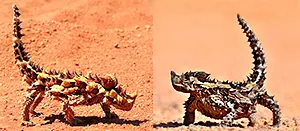
Photo: Thorny devil colours warm (left) cold (right)
The thorny devil is a cold-blooded (ectotherm) lizard. It regulates its body temperature using external sources such as sunlight or a warm surface. It usually starts the day with a drab olive-brown colour, and as it warms up, the thorny devil acquires its normal yellow, red and black colours. Because the thorny devil is cold-blooded and needs to warm its body up, it is active only during the day.
Thorny Devil Walking Thorny Dragon Running
Thorny Devil Walking
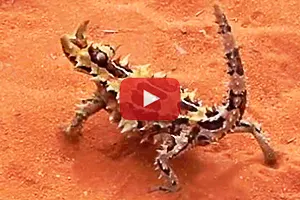 Watch Video of Thorny Devil Walking
Watch Video of Thorny Devil Walking
The thorny devil has a distinct walking style. First, it lifts its tail into a vertical position and then moves in a stop-and-go manner while oscillating back and forth as it progresses. We don’t know why it does this. Some experts speculate that this motion mimics the movement of a leaf blowing across the desert landscape when viewed from above, making it difficult for predatory birds to spot this little animal. This robotic movement adds to their camouflage ability (see video), as their frequent freezing makes them harder for a predator to detect. They can run short distances at up to 60 kph (37 mph).
Where Does the Thorny Devil Live? Thorny Devil Habitat
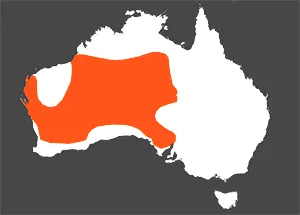
Photo: Thorny devil distribution map
The thorny dragon lives in spinifex grasslands, scrublands and deserts of the Australian Outback. It is found in Western Australia, the Northern Territory, south-western Queensland, and western South Australia. It is semi-nomadic, travelling from place to place in search of food. Thorny devils are most active around a temperature of 24°c and retire into underground borrows and remain inactive when the weather is extremely hot (January and February) or cold (June and July).
Thorny Devil Diet What Does A Thorny Devil Eat?
Thorny devils are obligate myrmecophages—they only eat black ants. A thorny devil may eat 600-3000 ants a day. They are ambush predators that find a suitable location where ants visit or pass through and then sit and wait to pick off their prey with their sticky tongues as they pass by. It has special shearing teeth for slicing through the relatively hard chitin bodies of its ant diet.
Their average feeding rate is three ants per minute. Their maximum consumption rate is a blistering one ant per second.
Living in the dry arid deserts, the thorny devil has evolved ingenious ways to quench its thirst. It uses its body as a condenser of moisture and its skin like a drinking straw to collect water from dew and transport it to its mouth. On cool mornings dew collects on its skin. This dew is channelled by capillary action to its mouth along grooves between its spines. This capillary action is so effective that water even defies gravity and travels up its legs. Capillary action also allows the thorny devil to absorb moisture from damp sand. Absorption through sand is the thorny devil's primary source of water intake.
Thorny Devil Reproduction & Life Cycle
Thorny devils mate once a year in the late winter through early summer (August to December). The courtship involves a lot of head bobbing and leg waving by the male. If she is receptive, he mounts her and deposits his sperm. The female usually digs a shallow burrow on a southern-facing sand ridge and deposits 3-10 eggs. She then covers up the burrow and abandons the site. Depending on the temperature of the soil, the eggs incubate for 90-132 days. The young hatchling's first meal is their own egg casing, which they eat before digging themselves out of the burrow.
Male and female thorny devils are the same size when they are born and grow at the same rate for the first year, after which the female outpaces the male in growth until they reach the age of 5 years.
Thorny Devil Predators & Threats Thorny Devil Self-defence
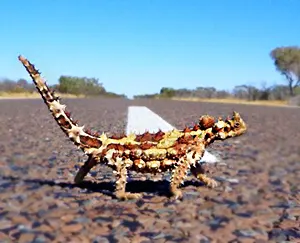
Photo: Thorny devil on a road
Even though thorny devils are well camouflaged and armoured, they fall prey to goannas and birds of prey. When threatened, they freeze, even in mid-step. They will also puff themselves up and tuck their head between their front legs, making themselves more difficult to attack and swallow.
Thorny devils are frequently killed by humans who destroy their habitats and accidentally run over them with motor vehicles as they bask on the surface of a warm road.
Thorny Devil Conservation Status Is the Thorny Devil Endangered?
The thorny devil population is believed to be unthreatened. It is illegal to own a thorny devil as a pet.
All Rights Reserved. (Last Updated: May 27, 202)